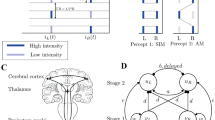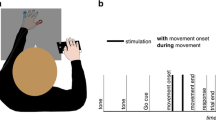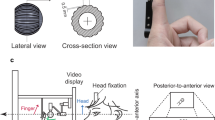Summary
The ability of subjects with a right-hand or left-hand preference to report accurately the number of tactile pulses in temporal sequences presented to preferred and nonpreferred hands was investigated as a function of temporal pattern complexity which varied in terms of intrinsic temporal relations among successive pulses and ranged from slow regular (periodic) sequences of small numbers of pulses to fast irregular (aperiodic) sequences of large numbers of pulses. As the complexity of the pattern increased in terms of pulse number, presentation rate, pulse density, and pulse aperiodicity, all subjects, for both preferred- and nonpreferred-hand stimulation, were increasingly less accurate in reporting the number of pulses in a temporal pattern. Most interesting was the finding that although hand-preference groups did not differ reliably in overall report accuracy, both groups showed a consistent shift in report accuracy from preferred- to nonpreferred-hand stimulation when patterns had more than seven pulses; furthermore, these shifts occurred for all presentation rates and pulse periodicities. A possible relationship between hand preference and cerebral psychological organization is suggested and the data are discussed in terms of the laterality differences reflecting basic underlying cerebral asymmetries in stimulus processing.
Similar content being viewed by others
References
Bakker, D.J.: Temporal order in disturbed reading. Rotterdam: University Press 1972
Bakker, D.J., van der Kleij, P.C.M.: Development of lateral asymmetry in the perception of sequentially touched fingers. Acta Psychol. 42, 357–365 (1978)
Bever, T.G.: Cerebral asymmetries in humans are due to the differentiation of two incompatible processes: holistic and analytic. Ann. NY Acad. Sci. 263, 251–262 (1975)
Bever, T.G., Chiarello, R.J.: Cerebral dominance in musicians and non-musicians. Science 185, 537–539 (1974)
Carmon, A.: Disturbances of tactile sensitivity in patients with unilateral cerebral lesions. Cortex 7, 83–97 (1971)
Dimond, S.J.: The double brain. London: Churchill Livingstone 1972
Efron, R.: The effect of handedness on the perception of simultaneity and temporal order. Brain 86, 261–284
Geschwind, N.: The anatomical basis of hemispheric differentiation. In: Hemispheric function in the human brain, Dimond, S.J., and Beaumont, J.G., (eds.). London: Elek Science 1974
Halperin, U., Nachson, I., Carmon, A.: Shift of ear superiority in dichotic listening to temporally patterned nonverbal stimul. J. Acoust. Soc. Am. 53, 46–50 (1973)
Kaufman, E.L., Lord, M.W., Reese, T.W., Volkman, J.: The discrimination of visual number. Am. J. Psychol. 62, 498–525 (1949)
Kimura, D.: Dual function asymmetry of the brain in visual perception. Neuropsychologia 4, 275–285 (1966)
Kimura, D.: The asymmetry of the human brain. Sci. Am. 228, 70–78 (1973)
Klahr, D.: Quantification Processes. In: Visual information processing, Chase, W.G. (ed.). New York: Academic Press 1973
Klahr, D., Wallace, J.G.: Cognitive development. Hillsdale, N. J.: Lawrence Erlbaum Associates 1976
Lechelt, E.C.: Spatial numerosity discrimination as continent upon sensory and extrinsic factors. Percept. Psychophys. 10, 180–184 (1971)
Lechelt, E.C., Tanne, G.: Laterality in the perception of successive tactile pulses. Bull. Psychonom. 7, 452–454 (1976)
Levy-Agresti, J., Sperry, R.W.: Differential perceptual capacities in major and minor hemisphere. Proc. U.S. Nat. Acad. Sci. 1151 (1968)
Milner, B., Taylor, L.: Right hemisphere superiority in tactile pattern recognition after cerebral commissurotomy: evidence for nonverbal memory. Neuropsychologia 10, 1–15 (1972)
Papcun, G., Krashen, S., Terbeek, D., Remington, R., Harshman, R.: Is the left hemisphere specialized for speech, language and/or something else? J. Acoust. Soc. Am. 55, 319–327 (1974)
Robinson, G.M., Solomon, D.: Rhythm is processed by the speech hemisphere. J. Exp. Psychol. 102, 508–511 (1974)
Semmes, J.: Hemispheric spezialization: a possible clue to mechanism. Neuropsychologia 6, 11–26 (1968)
Teuber, H.L.: Why two brains? In: The neurosciences: Third study program, Schmitt, F.O., and Worden, F.G. (eds.). Cambridge, Mass.: MIT Press 1974
Author information
Authors and Affiliations
Additional information
These investigations were supported by Grant A8621 from the National Research Council of Canada. This paper was prepared while the author was a Visiting Researcher at the Department of Psychology, University of Stockholm, and supported, in part, by a Leave Fellowship awarded by the Social Sciences and Humanities Research Council of Canada. I would like to thank Gordon Tanne for his assistance in data collection and analysis. Requests for offprints should be sent to E.C. Lechelt, Department of Psychology, University of Alberta, Edmonton, Alberta, Canada T6G 2E9.
Rights and permissions
About this article
Cite this article
Lechelt, E.C. Laterality differences and shifts as a function of tactile temporal pattern complexity: Implications for differential processing strategies of the cerebral hemispheres. Psychol. Res 41, 319–333 (1980). https://doi.org/10.1007/BF00308877
Received:
Issue Date:
DOI: https://doi.org/10.1007/BF00308877




